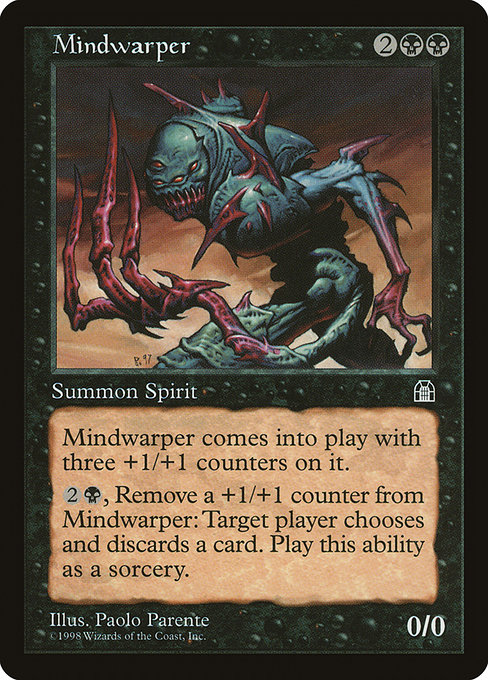
Image courtesy of Scryfall.com
From Ink to Legacy: Paolo Parente’s Mindwarper and the Stronghold Era
In the late 1990s MTG moment when black mana often wore the cloak of resource denial and strategic manipulation, Paolo Parente’s artwork for Mindwarper stood out with a quiet, unnerving confidence 🧙🔥. The image isn’t just a pretty frame; it’s a visual invitation into a world where minds bend, not just bodies break. Painted for the Stronghold expansion, released in 1998, this piece embodies an era when card art began to straddle the line between fantasy illustration and cinematic mood boards. The Spirit’s silhouette rings with a certain stoic menace, a hallmark of black’s philosophical edge in that era 🎨.
What’s on the table: Mindwarper’s tabletop resume
Here’s a concise map of the card’s identity and how it plays out on the battlefield, using the data that has helped fans study and collect for decades:
- Mana cost: 2 generic and 2 black ({2}{B}{B}) — a four‑mana commitment for a flexible, midrange body.
- Type: Creature — Spirit
- Power/Toughness: 0/0, but it enters with three +1/+1 counters, effectively turning it into a 3/3 when it lands.
- Oracle text: This creature enters with three +1/+1 counters on it. {2}{B}, Remove a +1/+1 counter from this creature: Target player discards a card. Activate only as a sorcery.
- Rarity: Rare
- Artist: Paolo Parente
- Set: Stronghold (STH), released in 1998-03-02
- Color identity: Black
- Legalities: Legacy and Vintage formats are among those where Mindwarper finds a home in the right shells; it’s a reminder that older cards can still provoke modern nostalgia and deckbuilding creativity.
On the table, Mindwarper is a patient spellcaster. It arrives with a potent defensive power—three fresh +1/+1 counters—that gives it a respectable first impression, especially in the days when a 4‑mana threat was expected to bring something noticeable to the board. The activated ability, though it comes with a sorcery speed requirement, transforms those counters into card advantage for you. Remove a counter, and your opponent must discard a card. It’s a clean, understated push that scales with patience—perfect for a meta where tempo and hand disruption shaped many a game plan 🧙🔥.
Flavor, lore, and the mental terrain of black mana
The Mindwarper’s flavor aligns with black’s long-running theme of cunning over brute force. It’s the kind of card that rewards thinking several moves ahead: you’re not smashing a creature down; you’re whittling away at an opponent’s resources, one card at a time, while your own life total stays in the wings until the moment you slip the decisive blow ⚔️. In Stronghold’s gothic corridors, where counterplay and control were celebrated, Mindwarper exemplified how a seemingly modest body could loom large through the leverage of a carefully spent ability.
Mindwarper embodies that old-school control ethos: leverage the board state, tax the opponent’s grip on the game, and use a few well-timed steps to tilt the outcome in your favor. A quiet champion of memory and tempo, long past its glory days but never fully forgotten by those who cut their teeth on era-defining black decks. 🧙🔥
Artistic imprint: Parente’s science-fantasy touch
Paolo Parente’s illustration for this card is a masterclass in atmosphere. The figure of the Mindwarper feels like it’s both there and not there—a spectral presence woven from shadow, light, and a glimmering aura that hints at the influence it wields. The piece sits at the intersection of fantasy illustration and the near-future vibe of late-90s science fiction, a tell-tale sign of Parente’s ability to fuse narrative clarity with mood. That balance of clarity and mystery is exactly what keeps this art memorable, especially when you’re flipping through a binder and spotting the familiar brushwork that defined that era 🎨.
Collectors often point to this card as a reminder that MTG’s art is more than illustration; it’s a gateway to memory. For longtime players, Mindwarper’s image triggers a cascade of tournaments, debates, and sleeved aesthetic experiments—each card a tiny portal to the late 1990s magic bubble of discovery and debate 🧩.
Collectibility, legacy, and modern re-appreciation
Mindwarper’s rarity and the era’s printing realities mean it’s a piece that often ends up in nostalgia-focused collections, rather than top-tier power‑cards in today’s Constructed metas. The Stronghold era itself is fondly remembered for its flavor-forward design, and Mindwarper sits as a representative of how black mana could deliver both presence on the board and a pathway to hand disruption without relying on flashy, high-cost spells. Its status as a card that remains legal in Legacy and Vintage — even if it’s not a staple in every deck — gives it a particular charm for vintage players who relish the memory of garnering first‑edition cross-format respect 🧙🔥💎.
For fans who appreciate the convergence of card art and game design, Mindwarper is a gateway card: approachable in its cost, inventive in its effect, and iconic in its era. The EDHREC rank on this Type card sits in the long tail, a reminder that every MTG card has a story to tell when you look beyond the current standard-leaning vantage point. The card’s history — from Paolo Parente’s brush to the Stronghold print run — is a vivid case study in how artwork, flavor, and mechanics collaborate to keep a single creature alive in the collective imagination 🧙🔥⚔️.
And if you’re looking to carry a little piece of that MTG memory into daily life, a small nod to the hobby’s stylish side can be found in curated accessories that celebrate the multiverse. The product below is a stylish, practical way to keep your cards—and your toast of nostalgia—close at hand during commutes, conventions, or casual Fridays.